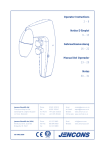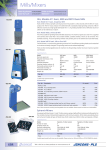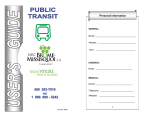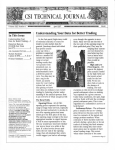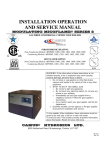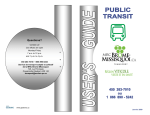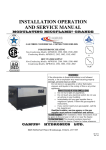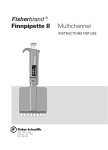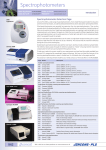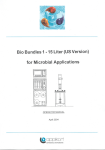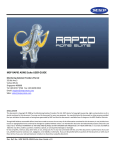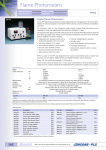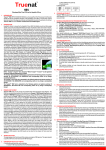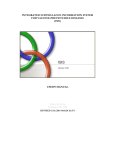Download manual - Pipette.com
Transcript
SEALPE TTE PRO Operator Instructions SEALPE TTE PRO Operator Instructions 1 – 16 Specifications 17 14 14 13 14 13 13 11 11 11 12 12 12 10 10 9 9 7 8 10 7 8 9 7 8 6 3 5 3 5 4 2 480-095, 480-039, 480-096 6 2 480-097, 480-098 1 5 480-099 1 1 Spare Parts 1 Tip ejector collar 8 Display 2 Tip cone holder 9 Handle 3 Tip cone complete 10 Tip ejector 4 Tip cone cylinder 11 ID window 5 Piston 12 ID tag 6 Piston seal 13 Handle collar 7 Calibration nut cover 14 Cap (set of 5 colours) 480-095 480-039 480-096 480-097 480-098 480-099 1 726051 726052 726052 726052 726053 726054 2 726041 726041 726041 726041 726042 N/A 3 731084 726083 726042 726039 726040 N/A 4 N/A N/A N/A N/A N/A 726038 5 731076 726084 726034 726035 726036 726037 6 N/A N/A N/A N/A N/A N/A 7 726006 726006 726006 726006 726006 726006 8 726022 726082 726026 726027 726028 726029 9 726086 726087 726088 726089 726090 726091 10 726005 726005 726005 726005 726005 726005 11 726004 726004 726004 726004 726004 726004 12 726003 726003 726003 726003 726003 726003 13 726002 726002 726002 726002 726002 726002 14 726001 726001 726001 726001 726001 726001 13 12 10 11 9 8 6 7 4 5 8-channel: 480-190, 480-191, 480-192 12-channel: 480-193, 480-194, 480-195 1 3 2 Spare Parts 1 Tip cone housing 8 Handle 2 Tip ejector bar 9 Tip ejector 3 Tip cone complete 10 ID window 4 Piston 11 ID tag 5 Piston assembly 12 Handle collar 6 Calibration nut cover 13 Cap (set of 5 colours) 7 Display 480-190 480-191 480-192 480-193 480-194 480-195 1 726131 726132 726133 726134 726135 726136 2 726137 726138 726138 726139 726140 726140 3 726149 726150 726151 726149 726150 726151 4 726146 726147 726148 726146 726147 726148 5 726152 726153 726154 726152 726153 726154 6 726006 726006 726006 726006 726006 726006 7 726022 726141 726142 726022 726141 726142 8 726143 726144 726145 726143 726144 726145 9 726005 726005 726005 726005 726005 726005 10 726004 726004 726004 726004 726004 726004 11 726003 726003 726003 726003 726003 726003 12 726002 726002 726002 726002 726002 726002 13 726001 726001 726001 726001 726001 726001 Specifications Sealpette Pro single-, 8- and 12-channel pipettors Cat. No. Channels Volume Range Test Volume 480-095 1 0.5 - 10 µl 10 µl 5 µl 1 µl 0.5 µl 1.00 1.50 2.50 5.00 480-039 1 2 - 20 µl 20 µl 10 µl 2 µl 0.90 % 1.20 % 3.00 % 0.40 % 1.00 % 2.00 % 480-096 1 10 - 100 µl 100 µl 50 µl 10 µl 0.80 % 1.00 % 2.00 % 0.15 % 0.40 % 1.00 % 480-097 1 20 - 200 µl 200 µl 100 µl 20 µl 0.60 % 0.80 % 2.00 % 0.15 % 0.30 % 0.80 % 480-098 1 100 - 1000 µl 500 µl 1000 µl 0.70 % 100µl 0.60 % 0.25 % 1.50 % 0.20 % 0.70 % Inacc. (%) % % % % Impr. (%) 0.60 1.00 1.50 4.00 % % % % 480-099 1 500 - 5000 µl 5000 µl 2500 µl 500 µl 0.50 % 0.60 % 1.50 % 0.15 % 0.30 % 0.60 % 480-190 8 0.5 - 10 µl 10 µl 5 µl 1 µl 1.50 % 2.50 % 4.00 % 1.00 % 2.50 % 4.00 % 480-191 8 5 - 100 µl 100 µl 50 µl 10 µl 0.70 % 1.00 % 3.00 % 0.25 % 0.70 % 1.50 % 480-192 8 30 - 300 µl 300 µl 150 µl 30 µl 0.60 % 1.00 % 2.00 % 0.25 % 0.50 % 1.00 % 480-193 12 0.5 - 10 µl 10 µl 5 µl 1 µl 1.50 % 2.50 % 4.00 % 1.00 % 2.50 % 4.00 % 480-194 12 5 - 100 µl 100 µl 50 µl 10 µl 0.70 % 1.00 % 3.00 % 0.25 % 0.70 % 1.50 % 480-195 12 30 - 300 µl 300 µl 150 µl 30 µl 0.60 % 1.00 % 2.00 % 0.25 % 0.50 % 1.00 % 17 CONTENTS 1. Product description 2 2. Jencons tips 4 3. Unpacking 4 4. Personal identification 4 5. Pipettor holder and carousel 5 5.1. Installing the pipettor holder 5 5.2. Carousel stand 5 6. Calibration tool (also tube and ID window opener) 5 7. Operating the pipettor 6 7.1. Setting the volume 6 7.2. Sealing and ejecting the tips 6 7.3. Protective tip cone filters and filter ejection 8. 9. Pipetting techniques 7 8 8.1. Forward pipetting 8 8.2. Reverse pipetting 8 8.3. Repetitive reverse technique 9 Recommendations for good pipetting 9 10. Maintenance 10 10.1. Daily cleaning of the outer surface of the pipettor 10 10.2. Cleaning and decontaminating the lower part of the pipettor 10 10.3. Sterilization of the pipettor 11. Testing the performance and recalibration 11 12 11.1. Testing the performance 12 11.2. Recalibration 14 12. Troubleshooting 15 13. Warranty information 16 14. Performance specifications 17 1 1. Product description Your new Jencons Sealpette Pro is an autoclavable air displacement pipettor. The attractive and ergonomical design of the Sealpette Pro pipettor together with its very low pipetting forces reduce the risk of repetitive strain injuries (RSI)1. The pipettor is designed for both rightand left-handed use. The special tip cone design of the pipettor offers the possibility to use replaceable tip cone filters to help prevent the contamination and damage of the pipettor. The operating button of the Sealpette Pro allows safe and easy filter ejection. The pipettor uses disposable tips. Jencons Sealpette Pro single- and multichannel pipettors Colour Cat. No. Tip Cone filters 50 pcs/bag Standard Plus Channels Volume Range Increment Tip 480-095 480-039 480-096 480-097 480-098 480-099 1-ch 1-ch 1-ch 1-ch 1-ch 1-ch 0.5 - 10 µl 2 - 20 µl 10 - 100 µl 20 - 200 µl 100 - 1000 µl 500 - 5000 µl 0.01 µl 0.02 µl 0.1 µl 0.2 µl 1 µl 10 µl 10 30 300, 350 300, 350 1000 5000 N/A 480-121 480-115 480-117 480-054 480-051 480-190 480-191 480-192 8-ch 8-ch 8-ch 0.5 - 10 µl 5 - 100 µl 30 - 300 µl 0.01 µl 0.1 µl 0.2 µl 10 300, 350 350 N/A N/A 480-115 480-116 480-117 480-118 480-193 480-194 480-195 12-ch 12-ch 12-ch 0.5 - 10 µl 5 - 100 µl 30 - 300 µl 0.01 µl 0.1µl 0.2 µl 10 300, 350 350 N/A N/A 480-115 480-116 480-117 480-118 N/A N/A 480-116 480-118 480-119 480-120 1. Note: It is knowledge that prolonged pipetting can cause RSI. The manufacturer is not responsible for RSI or any related diseases caused by prolonged pipetting. 2 Pipettor Description Tip ejector ....... .... .. Operating button ................... ID window and tag ........ Cap ....................... Finger support ......Handle Display ............. Volume lock .................. .. Calibration nut Tip ejector collar ...................... Tip cone.................... Tip Cone ........ filter Tip cone ......... ......Tip cone housing Tip ......ejector bar .......Tip Cone filter 3 2. Sealtips The full range of Sealtips are recommended for use with Jencons Sealpette Pro pipettors. Jencons standard tips are made of virgin polypropylene. Jencons also offers a full range of filter tips. Jencons Superfine tips are available as bulk packages and autoclavable (121°C, 20 min, 1 atm) trays. Pre-sterilized tips in trays are also available. 3. Unpacking The Jencons Sealpette Pro pipettor package contains the following items: 1. 2. 3. 4. 5. 6. 7. 8. 9. 10. Pipettor Tip Caps for colour coding Calibration tool (also tube and ID window opener) Pipettor holder Identification tags Tip cone filters (pipettors >10 ml) Grease Instruction manual Performance certification in accordance with ISO 8655-6 Please check that all items are included and that no damage has occurred during shipment. 4. Personal identification Each Jencons Sealpette Pro pipettor can be identified with a tag located under the ID window which is placed on the finger support. 1. 2. 3. Remove the ID window by using the calibration tool (Chapter 6.). Remove the tag and mark the identifying information on it. Position the tag on place and clip the window back into place. 4 5. Pipettor holder and carousel stand For convenience and safety always keep the pipettor vertically on its own holder or carousel stand when not in use. Cat.No. 481-123 Product Jencons Sealpette Pro Carousel Stand 5.1. Installing the pipettor holder 1. 2. 3. 4. Clean the shelf surface with ethanol. Remove the protective paper from the adhesive tape. Install the holder by pressing it against the edge of the shelf (Fig. 2). Place the pipettor onto the holder. Fig. 2. 5.2. Carousel stand A convenient and ergonomical Carousel Stand (Fig. 3) for six Jencons Sealpette Pro pipettors is also available. Fig. 3. 6. Calibration tool (also tube and ID window opener) The 1. 2. 3. calibration tool is designed for the following purposes (Fig. 4): Tool for recalibration (A). Opening tool for the ID window and lid of the calibration nut (B). Opening tool for the tubes (C). B Fig. 4. C A 5 7. Operating the pipettor 7.1. Setting the volume The volume of the pipettor is clearly shown through the display. The volume setting is carried out with the following steps (Fig. 5): 1. 2. 3. Press the volume lock and hold it down. Set the volume by rotating the operating button (clockwise to decrease the volume and counterclockwise to increase). Release the volume lock. Fig. 5 Volume Lock + – Note: Do not rotate the operating button without pressing down the volume lock. Do not rotate the operating button outside the volume range of the pipettor (Chapter. 1.) 7.2. Sealing and ejecting tips To ensure the maximum accuracy and precision Jencons tips are recommended to be used with Sealpette Pro pipettors. Before fitting a tip ensure that the pipettor tip cone is clean. Press the tip on the tip cone of the pipettor. The pipettor is provided with a spring loaded tip cone for optimal sealing. Eject the tip by pressing the tip ejector with your thumb (Fig. 6). Make sure that the tip is disposed into a suitable waste container. Fig. 6. Tip ejector Note: If the tip is pressed too hard the tip cone yields and, as a result, the counter and operating button moves. 6 7.3. Protective tip cone filters and filter ejection The tip cone design of the Jencons Sealpette Pro pipettors (> 10 ml) allows the use of Jencons tip cone filters in the tip cones. These removable filters prevent liquids and aerosols from entering the pipettor and, thus, protects the pipettor from contamination and damage. The tip cone filters are available as Standard or Plus versions. It is recommended to use the Standard filter for general applications and the Plus filter for more demanding applications such as cell culture, bacterial and virological work and molecular biology. Filters need to be changed regularly. The interval for filter changing is application dependant but the recommendation is to change the filter daily (after 50 – 250 pipetting cycles) and always in case of over-aspiration. (See Chapter 1 for ordering information.) The tip cone filters can be removed with the unique filter ejector without touching the filters by hand. Remove the operating button cap and eject the filter by pressing the operating button down (Fig. 7). Make sure that the filter is disposed into a suitable waste container. Clean the tip cone if needed and put the new filter in place. Fig. 7. 7 8. Pipetting techniques Two basic pipetting techniques, forward and reverse pipetting, are associated with Sealpette Pro pipettors. Forward pipetting is the most common used pipetting technique. The technique employs the blowout function ensuring complete delivery of the liquid. Reverse pipetting is recommended for highly viscous, biological or foaming liquids, or very small volumes of liquid. A selected volume plus an excess is aspirated into the tip. The delivery is done without blow-out, and, thus, the excess volume remains in the tip. The reverse technique also facilitates the repeated delivery of the same volume. 8.1. Forward pipetting (Fig. 8) 1. 2. 3. 4. Fit the tip onto the pipettor tip cone. Press the operating button to the first stop. Place the tip just under the surface of the liquid (2-3 mm) and smoothly release the operating button up to the starting position. Wait one second. Carefully withdraw the tip from the liquid, touching against the edge of the container to remove excess from the outside of the tip. Dispense the liquid by pressing the operating button to the first stop. After a short delay press the operating button to the second stop. This action will empty the tip. Fig. 8. 0 1 2 8.2. Reverse pipetting (Fig. 9) 1. 2. 3. 4. 5. 6. Fit the tip onto the pipettor tip cone. Press the operating button all the way to the second stop. Place the tip just under the surface of the liquid (2–3 mm) and smoothly release the operating button up to the starting position. Withdraw the tip from the liquid touching against the edge of the container to remove excess. Press the operating button smoothly to the first stop to deliver the present volume. Hold the operating button at the first stop. The liquid that remains in the tip should not be included in the delivery. Discard the remaining liquid by pressing the operating button to the second stop. Fig. 9. 0 1 2 8 8.3. Repetitive reverse technique 1. 2. 3. Follow the reverse technique steps 1 to 5. Continue pipetting by repeating steps 3 to 5 as long as needed. Finally discard the remaining liquid by pressing the operating button to the second stop. 9. Recommendations for good pipetting • • Make sure that the tip is firmly attached to the tip cone. Hold the pipettor vertically when aspirating the liquid and place the tip only a few millimetres into the liquid. Always control the operating button slowly and smoothly. Pre-rinse the tip before aspirating the liquid by filling and emptying the tip for three to five times. This is important especially when pipetting liquids with a viscosity and density greater than water or liquids with high vapour pressure (e.g. ethanol). Check that the pipettor, tip and liquid are at the same temperature. When pipetting liquids with temperatures different to the ambient temperature change the tip after each pipetting. Do not pre-rinse the tip. To avoid contamination, do not rest the pipettor on its side especially with the tip attached. Change the tip cone filter regularly (recommendation after 50 – 250 pipetting cycles). Never strike the tip cone against the tip tray when mounting the tip as this can damage the pipettor. Avoid rough handling and do not drop the pipettor. Avoid exposing the unit to extreme temperature changes, humidity and dust (operating temperature from 15ºC to 40ºC). • • • • • • • • • 9 10. Maintenance Jencons Sealpette Pro pipettors have been designed for easy in-house service. If the pipettor is used daily it is recommended to clean/decontaminate and check the performance of the pipettor every three months. Jencons also provides complete repair and recalibration service for your pipettor including a service report and performance certificate. Note: Please make sure that the pipettor has been decontaminated before you send it to us or your local representative. Please advise if any hazardous material has been used with your pipettor. Note: The use of the tip cone filters may prolong the interval of the service. Change the filters regularly. Note: It is recommended to always use gloves when cleaning the pipettor. 10.1. Daily cleaning of the outer surface of the pipettor Your Jencons Sealpette Pro pipettor should be checked every day for cleanliness. To clean and decontaminate the outer surface of your pipettor use ethanol (70%), isopropanol (60%) or a mild detergent as a cleaning agent and a soft lint-free cloth. Gently clean the surface of the pipettor with moistened cloth and wipe dry. Pay special attention to the tip cone. Change the tip cone filter if needed (Chapter 7.3.) 10.2. Cleaning and decontaminating the lower part of the pipettor If your pipettor is in daily use it is recommended to clean/decontaminate and grease the pipettor every three months. It is recommended to send the multichannel pipettors to your local Jencons service representative for cleaning and greasing. To clean and decontaminate the lower parts of the single channel pipettor, follow these steps: Disassembling and cleaning (see the pictures under the cover page): 1. Eject the tip cone filter (if fitted, Chapter 7.3.) 2. Unscrew the tip ejector collar (1) counterclockwise and remove it. 3. Pipettors 480-095, 480-039, 480-096, 480-097, 480-098: Unscrew the tip cone holder (2) counterclockwise and carefully remove it with the tip cone (3). Pipettor 480-099: Unscrew the tip cone cylinder (4) counterclockwise and remove it. 4. Clean the tip ejector collar, the tip cone holder, the tip cone (cylinder) and the piston (5) with ethanol (70%), isopropanol (60%) or mild detergent and soft lint-free cloth. 5. Clean the interior of the tip ejector collar and the tip cone (cylinder) with a cotton swab. Be careful with the pipettors 480-095, 480-039 and 480-096 so that the seal inside the tip cone will not damage. 6. Rinse the parts with distilled water if needed and let the parts dry. 10 7. Pipettors 480-095, 480-039 and 480-096: Put a thin layer of grease on the piston (5). Pipettors 480-097 and 480-098: Put a thin layer of grease around the seal (6). Pipettor 480-099: Put a thin layer of grease on the seal (6) and the interior of the tip cone cylinder (4). Note: Avoid excess grease. Use only the grease provided with the pipettor. Note: Before reassembling check that no lint or particles are on the surface of the piston. Decontamination: For complete decontamination of the lower parts place the tip ejector collar (1), tip cone holder (2), tip cone (3) and tip cone cylinder (4) (only the model 480-099) into a beaker containing ethanol (70%) isopropanol (60%) or a mild detergent and leave for at least 30 minutes. Wipe the piston with Jencons Proline‚ Biocontrol and the lint-free cloth. Rinse the parts with distilled or sterile water. Let the parts dry. Grease the piston and seal according to the instructions given earlier in this chapter. Reassembling: 1. Pipettors 480-095, 480-039, 480-096, 480-097, 480-098: Carefully place the tip cone (3) on the piston and attach it by screwing the tip cone holder (2) clockwise. Pipettor 480-099: Carefully place the tip cone cylinder (4) on the piston and screw clockwise. Make sure that the tip cone (cylinder) is properly tightened. Avoid over tightening. 2. Attach the tip ejector collar (1) by screwing it clockwise. 3. Place the new tip cone filter on its place. 4. Press the operating button several times to ensure that the grease has spread evenly. 5. Check the performance of the pipettor. Note: It is always necessary to check the performance of the pipettor after in-house service or maintenance. 10.3. Sterilization of the pipettor The entire Sealpette Pro pipettor can be sterilized by steam autoclaving at 121OC, (252OF), 1 atm for 20 minutes. Remove the tip cone filter (if fitted, Chapter 7.3). The single channel pipettors can be autoclaved without special preparations. Unscrew the Fig. 10 lower part of the multichannel pipettors by holding the connecting collar and turning the lower part Connecting 360° anticlockwise (Fig. 10). Put the collar pipettor into the sterilization bag and place it into the autoclave. After autoclaving the pipettor must be 360° 11 cooled down and left to dry overnight before use. Screw the lower part of the multichannel pipettors by holding the connecting collar and turning the lower part 360° clockwise. Make sure that the lower part is properly tightened. It is recommended to check the performance of the pipettor after every autoclaving. It is also recommended to grease the piston/seal of the pipettor after every 10 autoclaving. 11. Testing the performance and recalibration It is recommended to check the performance of your Jencons Sealpette Pro pipettors regularly (e.g. every 3 months) and always after in-house maintenance. However, the user should establish a regular testing routine for their pipettors with regard to accuracy requirements of the application, frequency of use, number of operators using the pipettor, nature of the liquid dispensed and the acceptable maximum permissible errors established by the user. (ISO 8655-1.) 11.1. Testing the performance Performance testing should take place in a draught-free room at 15 – 30OC, constant to +/- 0.5OC and humidity above 50%. The pipettor, tips and the test water should have stood in the test room a sufficient time (at least 2 hours) to reach equilibrium with the room conditions. Use distilled or deionised water (grade 3, ISO 3696). Use an analytical balance with a readability of 0.01 mgs. (ISO 8655-6.) Weighing 1. Adjust the desired test volume Vs. 2. Carefully fit the tip onto the tip cone. 3. Fill the tip with test water and expel to waste five times to reach a humidity equilibrium in the dead air volume. 4. Replace the tip. Pre-wet the tip by filling it once with test water and expel to waste. 5. Aspirate the test water, immersing the tip only 2-3 mm below the surface of the water. Keep the pipettor vertical. 6. Withdraw the pipettor vertically and touch the tip against the inside wall of the test water container. 7. Pipette the water into the weighing vessel, touching the tip against the inside wall of the vessel just above the liquid surface at an angle of 30° to 45°. Withdraw the pipettor by drawing the tip 8-10 mm along the inner wall of the weighing vessel. 8. Read the weight in mgs (mi). 9. Repeat the test cycle until 10 measurements have been recorded. 10. Convert the recorded masses (mi) to volumes (Vi) Vi = mi Z Z = correction factor (Table 1) 11. Calculate the mean volume (V) delivered: V = (∑Vi)/10 12. For conformity evaluation calculate the systematic error es of the measurement: in µl: es = V – Vs Vs = selected test volume or in %: es = 100 (V – Vs)/Vs 12 13. For conformity evaluation calculate the random error of the measurement: as standard deviation s = ∑(Vi – V)2 n = number of measurement (10) n–1 or as coefficient of variation CV = 100s/V 14. Compare the systematic error (inaccuracy) and random error (imprecision) with the values in the performance specifications (page 81) or the specifications of your own laboratory. If the results fall within the specifications, the pipettor is ready for use. Otherwise check both systematic and random errors and, when necessary, proceed to the recalibration procedure (Chapter 11.2). Note: Systematic error (inaccuracy) is the difference between the dispensed volume and the selected test volume. Random error (imprecision) is the scatter of the dispensed volumes around the mean of the dispensed volume. (ISO 8655-1.) Note: Jencons specifications are achieved in strictly controlled conditions (ISO 8655-6). The user should establish own specifications based on the field of use and the accuracy requirements placed on the pipettor (ISO8655-1). Table 1 Temp. (°C) 20.0 20.5 21.0 21.5 22.0 22.5 23.0 23.5 95 1.0028 1.0029 1.0030 1.0031 1.0032 1.0033 1.0034 1.0036 Z-values (µl/mg): Air Pressure (kPa) 100 1.0028 1.0029 1.0031 1.0032 1.0033 1.0034 1.0035 1.0036 Note: This method is based on ISO 8655. 13 101.3 1.0029 1.0030 1.0031 1.0032 1.0033 1.0034 1.0035 1.0036 105 1.0029 1.0030 1.0031 1.0032 1.0033 1.0034 1.0036 1.0037 11.2. Recalibration The calibration of your Sealpette Pro pipettor has been factory checked and certified at 22OC using grade 3 distilled water according to ISO 3696. The calibration is based on ISO 8655-6: Gravimetric test method for volumetric instruments. The pipettor’s specifications are guaranteed only with genuine Jencons tips. If you find the pipettor to be inaccurate after performance testing, please follow the instructions below: 1. 2. 3. 4. Remove the lid of the calibration nut, located at the backside of the handle, with the aid of the calibration tool (Fig. 11). Place the hexagonal head of the calibration tool into the hole of the calibration nut. Turn the adjustment lock anticlockwise to decrease and clockwise to increase the volume. Repeat testing the performance procedure (Chapter 11.1.). Continue until the results are correct. Note: Jencons offers accredited calibration service. Please contact your Jencons representative for further information. Fig. 11. – + 14 12. Trouble shooting Symptom Possible cause Solution Droplets left inside the tip Unsuitable tip Use original tips Leakage or pipetted volume too small Non-uniform wetting of the plastic Attach new tip Tip incorrectly attached Attach firmly Unsuitable tip Use original tips Foreign particles between tip and tip cone Clean the tip cone, attach new tip Tip cone holder incorrectly tightened Tighten the tip cone holder Pipettor damaged Return to your Jencons service representative for servicing Incorrect operation Follow instructions Unsuitable tip Use original tips Calibration altered Recalibrate Liquid has penetrated tip cone and dried Clean and grease the piston/seal and the tip cone Tip cone filter has been contaminated Change filter Insufficient amount of grease on a piston and seal Grease accordingly Tip ejector collar has been contaminated Remove and clean the ejector collar and tip cone Pipettor out of established specifications Operating button jammed or moves erratically Tip ejector jammed or moves erratically 15 13. Warranty information The Jencons Sealpette Pro pipettors are covered by warranty for 3 years against defects in materials and workmanship. Should your Sealpette Pro pipettor fail to function at any time, please contact your local Jencons representative. ANY WARRANTY WILL, HOWEVER, BE DEEMED AS VOID IF FAULT IS FOUND TO HAVE BEEN CAUSED BY MALTREATMENT, MISUSE, UNAUTHORIZED MAINTENANCE OF SERVICE OR NEGLIGENCE OF REGULAR MAINTENANCE AND SERVICE, ACCIDENTAL DAMAGE, INCORRECT STORAGE OR USE OF THE PRODUCTS FOR OPERATIONS OUTSIDE THEIR SPECIFIED LIMITATIONS, OUTSIDE THEIR SPECIFICATIONS, CONTRARY TO THE INSTRUCTIONS GIVEN IN THIS MANUAL OR WITH OTHER THAN THE MANUFACTURER’S ORIGINAL TIPS. Each Jencons Sealpette Pro pipettor is tested before shipping by the manufacturer. The Jencons Quality Assurance Procedure guarantees that the Jencons Sealpette Pro pipettor you have purchased is ready for use. Each Jencons Sealpette Pro pipettor is CE marked. 14. Performance specifications The manufacturer’s specifications are guaranteed only when the manufacturer’s original tips are used. The manufacturer’s specifications below should be used as guidelines when establishing your own performance specifications in accordance with ISO 8655. 16 Operator Instructions 1 – 16 Specifications 17 Jencons Scientific Ltd Cherrycourt Way Ind. Est. Stanbridge Rd, Leighton Buzzard Jencons Scientific Inc (USA) 800 Bursca Drive, Suite 801 Bridgeville, PA 15017 LU7 4UA, ENGLAND Phone: Fax: Int. Phone: 01525 372010 01525 379547 Phone: Toll Free: 800 846-9959 +44 1525 372010 Fax: 412 257-8809 Email: [email protected] Website: www.jenconsusa.com Int. Fax: +44 1525 851461 Email: [email protected] Int. Email: [email protected] Website: www.jencons.co.uk Online sales: www.ecomcat.co.uk 412 257-8861 ref: 502405






















